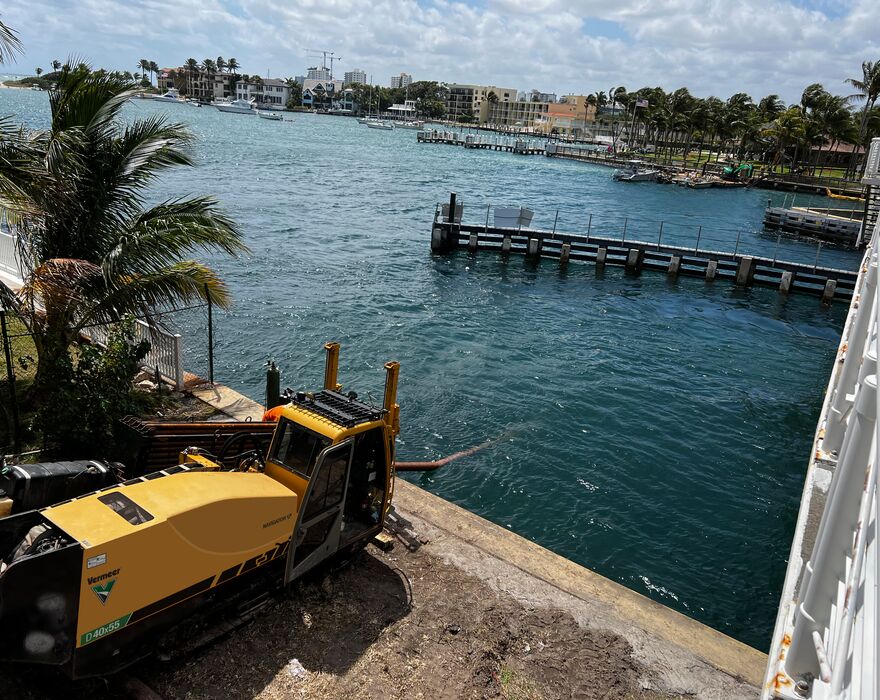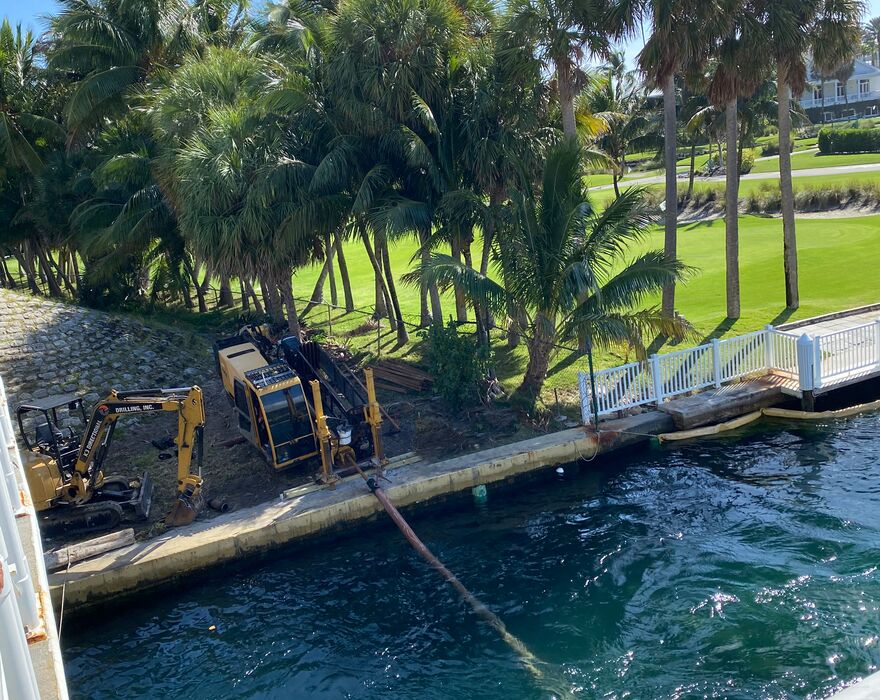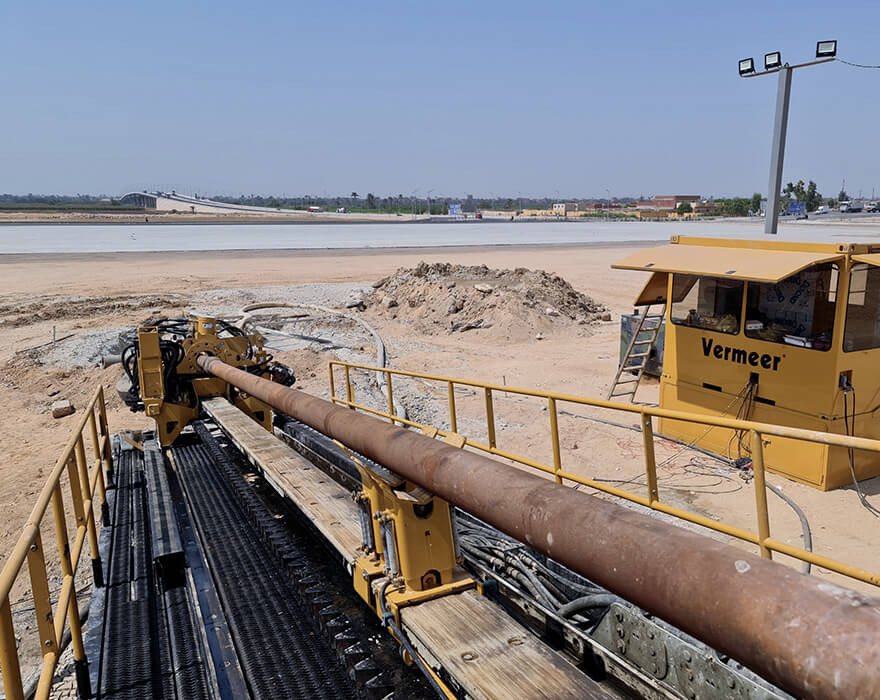The Florida Department of Transportation operates and maintains 51 movable bridges throughout the state’s eastern and western intracoastal areas. And in popular tourist destinations, city municipalities operate many more. These moveable bridges are critical for boat traffic and over-the-road vehicles.

However, over the last decade, many have become inoperable for extended periods of time because of electrical issues. The old electrical lines running across the bottom of the sea floor fail due to erosion and corrosion of the protective insulation wrapped around each one.
Bridging the gap with HDD
“It’s a real problem we’re seeing throughout the state of Florida because there is not a quick and permanent fix,” said Lewis Krantz, K3 Directional Drilling owner and vice president. “Florida officials have recognized that fixing the electrical issues on these inlet moveable bridges requires electrical lines to be installed below the surface at depths where future erosion will not be a problem.”
“But traditional installation methods, like dredging or jetting, are labor intensive and can be very disruptive to the traffic and the environment.”
Those challenges are why Quality Electric Contracting Inc. (QECI) first approached the K3 Directional Drilling team. Based in Clewiston, Florida, QECI has specialized in bridge electrical rehabs throughout Florida since 1972. QECI owners Dyoll Turner and Karson Turner enlisted K3 Directional Drilling’s services to design a bore for an inlet electrical crossing for a movable bridge a few years ago.
K3 Directional Drilling is well-known throughout Florida for planning and executing large and small utility installation projects. The company is a preferred partner of Walt Disney World, has helped build out critical infrastructure for The Villages retirement community, and regularly performs large-diameter horizontal directional drilling (HDD) projects for city municipalities. But it’s not just what Krantz’s team can do with a directional drill that sets the organization apart from other contractors — Krantz is an expert at planning and mapping out bores ahead of time. This is why the Turners enlisted Krantz’s help.
Mapping the perfect plan
“We’ve been using Vermeer BoreAid design tool and Vermeer Projects bore planning tools for years,” said Krantz. “These two boring tools are an integrated part of our operations and essential to our planning process.”
For these inlet projects, Krantz designed the bores so his crew could complete the shore-distance bores with minimal stress to the pipe and drill rod during the process.
“The inlet bores we’ve completed in Jacksonville, Sarasota, Naples, Fort Myers, New Smyrna, Delray Beach and Hobe Sound have only been approximately 100 feet (30 m) long. But they were all required to be approximately 15 feet (4.6 m) below the bottom of the inlet between the bridge fenders,” explained Krantz. “To achieve that, we needed to plan our setback distance and entry angles to reach the required depth while leaving enough space to come up on the other side before reaching the seawall. We also had to determine if there was enough space to position the drill on the seawall.”
With a better idea of the challenges his crew would encounter during the drilling process, Krantz determined the Vermeer D40x55 S3 horizontal directional drill was the right size machine for this type of work.
“We needed a machine that was powerful enough to drill through a cobble floor and could support the volumes of drilling fluid we would need to maintain the bore path from pilot bore to pull back,” said Krantz. “The drill also needed to have rods with some rigidity since the drill string would have to go through 20 feet to 40 feet (6 m to 12 m) of water before contacting the ground underneath. And finally, the drill needed to be light enough to be lifted into place by a crane.”
With a bore plan in hand, the K3 Directional Drilling crew got to work. Because of the limited access on these inlet bores, crews have to crane equipment into position ahead of time.
“In addition to the directional drilling, we usually have one or two mini excavators on hand to help with moving pipe around,” Krantz added. “The machines are typically hoisted into position on top of the seawall and walked onto a barge, if the project requires it. One of the major challenges with this process is the weather. We must ensure the water’s not too choppy and wait until the tide is right before work can begin.”
Unique ground conditions call for expert execution
The Hillsboro Inlet at Pompano Beach is one of the bores the K3 Directional Drilling team tackled in 2022. “This was one of the few inlet bores we’ve done that we could set up the drill on top of the seawall,” said Krantz. “But the ground underneath the water was rocky, requiring extra steps from our drill crew.”

The crew welded together steel casings, lowered them into the water and wedged them into the soft, sandy top layer of material at the bottom of the inlet. The drill operator then ran the drill rod through the pipe as it penetrated the subsurface below.
“With the entry angle of this bore, our drill string was approximately 40 feet (12 m) long before making contact with the bottom of the inlet,” explained Krantz. “The casing helped prevent the drill rod from flexing upon initial contact with the hard subsurface material. This setup and tooling, specifically designed for the cobble we would encounter, was a perfect combination for the conditions.”
After penetrating the seafloor, the drill operator continued to drill down until reaching a depth of 20 ft (6 m) below the surface. The bore leveled off between the bridge fenders before ascending and punching out on the other side. Crew members ran a mixture of water and AMC Gel throughout the bore. They like this drilling additive because of its hole-cleaning properties and filtration control in fresh or brackish water.
After the Hillsboro Inlet pilot bore, the crew swapped out the drill bit for a fluted reamer, attached a bundle of four 3-in (7.6-cm) HDPD pipes, and pulled back.
“In these conditions, we aren’t working with much space, and everything is happening in the water,” said Krantz. “Our talented people have a lot of experience performing bores that can’t be done exactly how you would like the process to go. They did a great job on this and on all the other inlet bores we’ve worked on.”
After pulling back the HDPE pipe, the K3 Directional Drilling team left around 200 ft (60 m) on each side of the bore. Electrical crews then connected the pipes to the nearest piling or embankment and tied them to the electrical system on each side of the bridge.
K3 Directional Drilling completed each inlet project in approximately a week.
The contractor has received a lot of inquiries about completing similar projects. To keep up with it all, Krantz added another Vermeer D40x55 S3 drill to his fleet.
“We have been really happy with how that drill model has performed on these crossings. Plus, we always have plenty of work for this size drill when we’re not doing inlet work,” he said.
Expand your opportunities with the right equipment
Since many bridges up and down Florida’s coastline have similar electrical issues, K3 Directional Drilling is anticipating many more inlet crossing projects in the coming years.
“What has made us successful at this type of work is diligent planning, employing great people and giving them the equipment and tools needed to get the job done efficiently,” said Krantz. “That’s what we’ve been doing since we started K3 Directional Drilling in 2015 and will continue to do, no matter where the work takes us.”
Tackling a unique jobsite in your neighborhood? Whether you’re trying to move bridges or install municipal utilities, take it from K3 Directional Drilling and start work on your bore plan and fleet strategy today. Contact your local Vermeer dealership for support.
Vermeer Corporation reserves the right to make changes in engineering, design and specifications; add improvements; or discontinue manufacturing at any time without notice or obligation. Equipment shown is for illustrative purposes only and may display optional accessories or components specific to their global region. Please contact your local Vermeer dealer for more information on machine specifications.
Vermeer and the Vermeer logo are trademarks of Vermeer Manufacturing Company in the U.S. and/or other countries. © 2023 Vermeer Corporation. All Rights Reserved.
